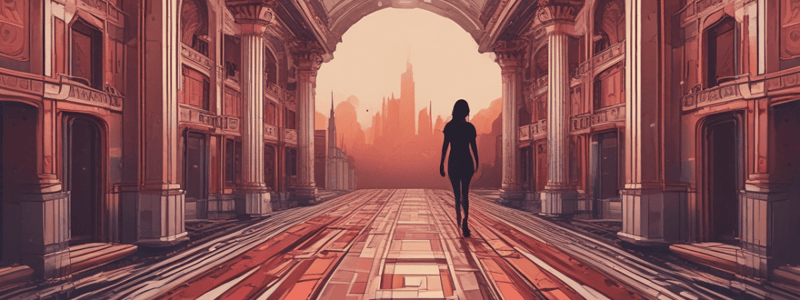Podcast
Questions and Answers
What is the primary purpose of using perspective and foreshadowing in visual art?
What is the primary purpose of using perspective and foreshadowing in visual art?
- To create a sense of movement in an artwork
- To create a sense of emotion in an artwork
- To create a sense of pattern in an artwork
- To create a sense of depth and space in an artwork (correct)
What is the principle behind linear perspective?
What is the principle behind linear perspective?
- Objects appear smaller as they move away from the viewer
- Objects that are closer are smaller and those farther away are larger
- Converging lines meet at a point on the horizon (correct)
- Objects become less distinct and bluer in color as they move farther away
What is atmospheric perspective also known as?
What is atmospheric perspective also known as?
- Aerial perspective (correct)
- Linear perspective
- Diminishing size perspective
- Linear size perspective
What technique is often used in elements such as rows of buildings, trees, or a group of people?
What technique is often used in elements such as rows of buildings, trees, or a group of people?
What is the result of using linear perspective correctly?
What is the result of using linear perspective correctly?
What is the name of the point where converging lines meet in linear perspective?
What is the name of the point where converging lines meet in linear perspective?
What is the principle behind atmospheric perspective?
What is the principle behind atmospheric perspective?
How do artists often draw objects in linear perspective?
How do artists often draw objects in linear perspective?
What is the purpose of foreshadowing in an artwork?
What is the purpose of foreshadowing in an artwork?
What is the effect of overlapping objects in a composition?
What is the effect of overlapping objects in a composition?
What role do cast shadows play in creating depth in an artwork?
What role do cast shadows play in creating depth in an artwork?
What is the purpose of placement and scale in creating depth in an artwork?
What is the purpose of placement and scale in creating depth in an artwork?
What is the result of layering and overlapping techniques in visual art?
What is the result of layering and overlapping techniques in visual art?
How does atmospheric perspective contribute to creating spatial illusions?
How does atmospheric perspective contribute to creating spatial illusions?
What is the effect of overlapping shapes and forms in a composition?
What is the effect of overlapping shapes and forms in a composition?
What is the purpose of transparency and translucency in a composition?
What is the purpose of transparency and translucency in a composition?
What is the result of using layering and overlapping techniques in a composition?
What is the result of using layering and overlapping techniques in a composition?
What is the purpose of creating a visual hierarchy in a composition?
What is the purpose of creating a visual hierarchy in a composition?
What is the primary purpose of layering and overlapping techniques in visual art?
What is the primary purpose of layering and overlapping techniques in visual art?
What can be achieved by consciously considering negative space in a composition?
What can be achieved by consciously considering negative space in a composition?
What is the primary function of negative space in a composition?
What is the primary function of negative space in a composition?
How can digital software be used in layering and overlapping techniques?
How can digital software be used in layering and overlapping techniques?
What is required to truly master layering and overlapping techniques?
What is required to truly master layering and overlapping techniques?
What can be achieved by distributing negative space strategically in a composition?
What can be achieved by distributing negative space strategically in a composition?
What is the definition of negative space?
What is the definition of negative space?
What can be used to create a sense of depth and distance in a composition?
What can be used to create a sense of depth and distance in a composition?
What can be achieved by contrasting positive and negative spaces?
What can be achieved by contrasting positive and negative spaces?
What is a result of using layering and overlapping techniques in visual art?
What is a result of using layering and overlapping techniques in visual art?
What is the primary purpose of utilizing negative space in a two-dimensional artwork?
What is the primary purpose of utilizing negative space in a two-dimensional artwork?
How does negative space help emphasize the subject in a composition?
How does negative space help emphasize the subject in a composition?
What emotion can dense negative space evoke in an artwork?
What emotion can dense negative space evoke in an artwork?
What can deliberate shapes within negative space add to a composition?
What can deliberate shapes within negative space add to a composition?
Why is negative space crucial in simplifying complex compositions?
Why is negative space crucial in simplifying complex compositions?
What can negative space ignite in the viewer of an artwork?
What can negative space ignite in the viewer of an artwork?
What can studying the works of renowned artists provide?
What can studying the works of renowned artists provide?
What is negative space in a composition?
What is negative space in a composition?
What is the result of manipulating negative space in a composition?
What is the result of manipulating negative space in a composition?
What is the goal of considering negative space in a composition?
What is the goal of considering negative space in a composition?
What can artists achieve by contrasting positive and negative spaces?
What can artists achieve by contrasting positive and negative spaces?
What can be achieved by distributing negative space strategically?
What can be achieved by distributing negative space strategically?
How can negative space enhance the perception of depth and volume?
How can negative space enhance the perception of depth and volume?
What can surrounding the subject with ample negative space achieve?
What can surrounding the subject with ample negative space achieve?
What can dense negative space feel like?
What can dense negative space feel like?
What can be created by deliberately creating shapes within the negative space?
What can be created by deliberately creating shapes within the negative space?
What can utilizing negative space effectively achieve?
What can utilizing negative space effectively achieve?
What can leaving certain areas open to interpretation achieve?
What can leaving certain areas open to interpretation achieve?
What can studying the works of renowned artists provide?
What can studying the works of renowned artists provide?
What is the result of understanding the relationship between positive and negative space?
What is the result of understanding the relationship between positive and negative space?
Flashcards are hidden until you start studying
Study Notes
Creating Depth and Space in Visual Art
- Creating depth and space in visual art is essential for providing a realistic and engaging experience for the viewer
- Two important techniques used to achieve this are perspective and foreshadowing
Understanding Perspective
- Perspective is a method used to create the illusion of depth and space on a two-dimensional surface
- There are three types of perspective: linear perspective, atmospheric perspective, and diminishing size perspective
- Linear perspective: relies on the concept of converging lines, objects appear smaller as they recede into the distance
- Atmospheric perspective: objects become less distinct and bluer in color as they move farther away
- Diminishing size perspective: objects appear smaller as they move away from the viewer
Mastering Foreshadowing
- Foreshadowing is a technique used to create depth and space in artworks
- It involves suggesting the presence of objects that are not fully visible, often hinting at their size and position through subtle visual cues
- Techniques used in foreshadowing include:
- Overlapping: placing objects in the foreground that partially cover objects in the background
- Cast Shadows: adding realistic cast shadows to objects to anchor them in space
- Placement and Scale: strategically placing objects within a composition to create a sense of depth
Layering and Overlapping Techniques
- Layering and overlapping techniques are used to manipulate space and depth in visual art
- Techniques include:
- Creating a Visual Hierarchy: layering objects to create a sense of depth and distance
- Atmospheric Perspective: layering objects with a gradual shift in value and color to simulate natural atmospheric effects
- Overlapping Shapes and Forms: overlapping objects to imply depth and create spatial illusions
- Transparency and Translucency: introducing transparency or translucency to add depth and dimension
- Overlapping Textures: layering textures to create a sense of depth and distance
- Collage and Mixed Media: combining different materials to create complex layers and spatial illusions
- Digital Layering and Overlapping: using digital software to experiment with layering and overlapping techniques
Negative Space
- Negative space is the area around and between objects in a composition
- Manipulating negative space can create a sense of balance, harmony, and depth in artworks
- Techniques for using negative space include:
- Creating Contrast: contrasting positive and negative spaces to attract attention
- Balancing the Composition: distributing negative space to achieve balance and equilibrium
- Enhancing Depth and Volume: using negative space to create the illusion of three-dimensionality
- Emphasizing the Subject: surrounding the subject with negative space to highlight its presence
- Establishing Emotional Tone: using negative space to evoke emotions and create atmosphere
- Experimenting with Shapes: creating deliberate shapes within negative space to add complexity and interest
- Simplifying the Composition: using negative space to eliminate unnecessary details and focus on essential elements
- Inspiring Imagination: using negative space to engage the viewer and invite interpretation
Studying That Suits You
Use AI to generate personalized quizzes and flashcards to suit your learning preferences.




